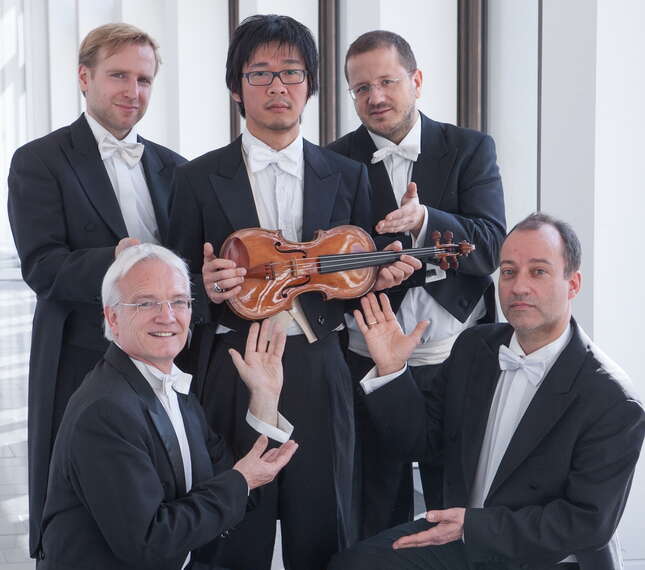
Ihre Suchergebnisse (9960 gefunden)


Ensemble percussion ensemble Jazz Minimal Avantgarde

Ensemble orchestra Württembergische Philharmonie Reutlingen
Württembergische Philharmonie Reutlingen
Gegründet im Jahre 1945 hat sich die Stiftung Württembergische Philharmonie inzwischen zu einem international gefragten Orchester entwickelt. Als künstlerische Leiter begleiteten unter anderem Salvador MasConde, Roberto Paternostro und bis August 2007 der japanische Dirigent Norichika Iimori den Werdegang des Klangkörpers. Iimori ist seither Ständiger Gastdirigent des Orchesters. Ab der Spielzeit 2008/2009 wird Ola Rudner neuer Chefdirigent der Württembergische Philharmonie.
Höhepunkt der jüngsten Orchestergeschichte war eine knapp dreiwöchige Japan-Tournee im Februar 2006, wo das Orchester im Rahmen des „Deutschlandjahrs in Japan“ unter der Schirmherrschaft des baden-württembergischen Ministerpräsidenten das Kulturleben Baden-Württembergs als offizieller Botschafter repräsentierte. Noch im selben Jahr folgte das hochgelobte Debüt der Württembergischen Philharmonie im Musikvereinssaal in Wien, im Juli 2007 spielte das Orchester zwei Konzerte bei den „Gustav Mahler Musikwochen“ in Toblach/Südtirol und Brixen.
Neben mehreren Konzertreihen in Reutlingen veranstaltet die Württembergische Philharmonie einen Konzert-Zyklus in der Barock-Basilika Weingarten, der vom SWR mitgeschnitten und für CD produziert wird. Das Orchester tritt zudem regelmäßig im Südwestrundfunk und im Deutschlandfunk in Erscheinung. Von 2004 bis 2006 war es als „Orchestra in residence“ bei den Internationalen Rossini-Festspiele in Bad Wildbad verpflichtet und wirkte dort mit namhaften Dirigenten zusammen. Seit 2005 ist die Württembergische Philharmonie regelmäßig zu Gast in der berühmten Sala Verdi in Mailand. Auf zahlreichen Tourneen u.a. durch Österreich, die Schweiz, Italien, Spanien und die Niederlande hat sich das Orchester ein hohes internationales Ansehen erworben. Äußerst erfolgreich waren eine Spanienreise und Galakonzerte mit der weltweit gefeierten Sopranistin Edita Gruberova im Jahr 2000 und mit José Carreras im Jahr 2001, sowie seit 1999 mehrere Schweiz-Tourneen u.a. mit Ruggero Raimondi, Vesselina Kasarova, Neil Shicoff, Peter Seiffert und zuletzt 2007 mit Agnes Baltsa. Weitere Schweiz-Tourneen finden bis 2010 mit Edita Gruberova (2008), Ramón Vargas (2009) und Thomas Hampson (2010) statt.
Erfolge feierte die Württembergische Philharmonie zudem im Amsterdamer Concertgebouw, bei den Rotterdamer Opernfestspielen sowie bei Neujahrskonzerten in Rom („Concerto della Pace“), in der Kölner und der Berliner Philharmonie, dem Münchner Herkulessaal, der Tonhalle Zürich sowie im Kultur- und Kongresszentrum Luzern, wo das Orchester regelmäßig gastiert. Die Württembergische Philharmonie arbeitet zusammen mit so renommierten Solisten wie z.B. Gidon Kremer, Daniel Hope, Radu Lupu, Andrej Gawrilow, Frank Peter Zimmermann, Natalia Gutman, Sabine Meyer und Anatol Ugorski und konzertiert unter namhaften Gastdirigenten wie z.B. Richard Bonynge, Leonid Grin, Alessandro de Marchi, Jac van Steen, Arild Remmereit, Fabrice Bollon und John Axelrod. Auch eine regelmäßige Zusammenarbeit mit international renommierten Ballettkompanien wie dem Royal Birmingham Ballett (Deutschland-Tournee), dem Ballett des Hessischen Staatstheaters Wiesbaden oder der Birgit-Keil-Stiftung bei den Ludwigsburger Festspielen zeichnet das Orchester aus, ebenso wie Gastspiele bei einer Reihe von bekannten Festivals wie dem „Choriner Musiksommer“, den „Herbstlichen Musiktagen Bad Urach“ oder den „Audi-Sommerkonzerten“.
2008 gastiert die Württembergische Philharmonie Reutlingen erstmals im Großen Festspielhaus in Salzburg und im Konzerthaus Dortmund, sie konzertiert mit dem weltberühmten Geiger Shlomo Mintz in Italien, bestreitet eine Ungarn-Tournee und kehrt außerdem auf Wiedereinladung für ein weiteres Gastspiel in den Wiener Musikvereinssaal zurück.
CD-Produktionen des Orchesters aus jüngster Zeit sind die CD „Orientalische Märchen“ mit Ottorino Respighis Ballettsuite „Belkis. Regina di Saba“ und Nikolai Rimski-Korsakows „Scheherazade“ unter der Leitung von Norichika Iimori (GENUIN), zwei von der internationalen Presse hoch gelobte CDs mit Werken von Astor Piazzolla unter Gabriel Castagna (Chandos), die Ersteinspielung von unbekannten Werken des Komponisten Paul Dukas unter Fabrice Bollon (Sterling) sowie eine Aufnahme der „Tschechischen Suite“ und der 9. Sinfonie „Aus der neuen Welt“ von Antonín Dvořák unter der Leitung von John Axelrod (GENUIN). Für den japanischen Markt spielte das Orchester 2006 alle Beethoven-Sinfonien unter der Leitung von Norichika Iimori ein und produzierte in Live-Mitschnitten aus Yokohama und Tokyo Brahms’ 1. Sinfonie und Akira Nishimuras „Fanfare für Orchester“.
Gegründet im Jahre 1945 hat sich die Stiftung Württembergische Philharmonie inzwischen zu einem international gefragten Orchester entwickelt. Als künstlerische Leiter begleiteten unter anderem Salvador MasConde, Roberto Paternostro und bis August 2007 der japanische Dirigent Norichika Iimori den Werdegang des Klangkörpers. Iimori ist seither Ständiger Gastdirigent des Orchesters. Ab der Spielzeit 2008/2009 wird Ola Rudner neuer Chefdirigent der Württembergische Philharmonie.
Höhepunkt der jüngsten Orchestergeschichte war eine knapp dreiwöchige Japan-Tournee im Februar 2006, wo das Orchester im Rahmen des „Deutschlandjahrs in Japan“ unter der Schirmherrschaft des baden-württembergischen Ministerpräsidenten das Kulturleben Baden-Württembergs als offizieller Botschafter repräsentierte. Noch im selben Jahr folgte das hochgelobte Debüt der Württembergischen Philharmonie im Musikvereinssaal in Wien, im Juli 2007 spielte das Orchester zwei Konzerte bei den „Gustav Mahler Musikwochen“ in Toblach/Südtirol und Brixen.
Neben mehreren Konzertreihen in Reutlingen veranstaltet die Württembergische Philharmonie einen Konzert-Zyklus in der Barock-Basilika Weingarten, der vom SWR mitgeschnitten und für CD produziert wird. Das Orchester tritt zudem regelmäßig im Südwestrundfunk und im Deutschlandfunk in Erscheinung. Von 2004 bis 2006 war es als „Orchestra in residence“ bei den Internationalen Rossini-Festspiele in Bad Wildbad verpflichtet und wirkte dort mit namhaften Dirigenten zusammen. Seit 2005 ist die Württembergische Philharmonie regelmäßig zu Gast in der berühmten Sala Verdi in Mailand. Auf zahlreichen Tourneen u.a. durch Österreich, die Schweiz, Italien, Spanien und die Niederlande hat sich das Orchester ein hohes internationales Ansehen erworben. Äußerst erfolgreich waren eine Spanienreise und Galakonzerte mit der weltweit gefeierten Sopranistin Edita Gruberova im Jahr 2000 und mit José Carreras im Jahr 2001, sowie seit 1999 mehrere Schweiz-Tourneen u.a. mit Ruggero Raimondi, Vesselina Kasarova, Neil Shicoff, Peter Seiffert und zuletzt 2007 mit Agnes Baltsa. Weitere Schweiz-Tourneen finden bis 2010 mit Edita Gruberova (2008), Ramón Vargas (2009) und Thomas Hampson (2010) statt.
Erfolge feierte die Württembergische Philharmonie zudem im Amsterdamer Concertgebouw, bei den Rotterdamer Opernfestspielen sowie bei Neujahrskonzerten in Rom („Concerto della Pace“), in der Kölner und der Berliner Philharmonie, dem Münchner Herkulessaal, der Tonhalle Zürich sowie im Kultur- und Kongresszentrum Luzern, wo das Orchester regelmäßig gastiert. Die Württembergische Philharmonie arbeitet zusammen mit so renommierten Solisten wie z.B. Gidon Kremer, Daniel Hope, Radu Lupu, Andrej Gawrilow, Frank Peter Zimmermann, Natalia Gutman, Sabine Meyer und Anatol Ugorski und konzertiert unter namhaften Gastdirigenten wie z.B. Richard Bonynge, Leonid Grin, Alessandro de Marchi, Jac van Steen, Arild Remmereit, Fabrice Bollon und John Axelrod. Auch eine regelmäßige Zusammenarbeit mit international renommierten Ballettkompanien wie dem Royal Birmingham Ballett (Deutschland-Tournee), dem Ballett des Hessischen Staatstheaters Wiesbaden oder der Birgit-Keil-Stiftung bei den Ludwigsburger Festspielen zeichnet das Orchester aus, ebenso wie Gastspiele bei einer Reihe von bekannten Festivals wie dem „Choriner Musiksommer“, den „Herbstlichen Musiktagen Bad Urach“ oder den „Audi-Sommerkonzerten“.
2008 gastiert die Württembergische Philharmonie Reutlingen erstmals im Großen Festspielhaus in Salzburg und im Konzerthaus Dortmund, sie konzertiert mit dem weltberühmten Geiger Shlomo Mintz in Italien, bestreitet eine Ungarn-Tournee und kehrt außerdem auf Wiedereinladung für ein weiteres Gastspiel in den Wiener Musikvereinssaal zurück.
CD-Produktionen des Orchesters aus jüngster Zeit sind die CD „Orientalische Märchen“ mit Ottorino Respighis Ballettsuite „Belkis. Regina di Saba“ und Nikolai Rimski-Korsakows „Scheherazade“ unter der Leitung von Norichika Iimori (GENUIN), zwei von der internationalen Presse hoch gelobte CDs mit Werken von Astor Piazzolla unter Gabriel Castagna (Chandos), die Ersteinspielung von unbekannten Werken des Komponisten Paul Dukas unter Fabrice Bollon (Sterling) sowie eine Aufnahme der „Tschechischen Suite“ und der 9. Sinfonie „Aus der neuen Welt“ von Antonín Dvořák unter der Leitung von John Axelrod (GENUIN). Für den japanischen Markt spielte das Orchester 2006 alle Beethoven-Sinfonien unter der Leitung von Norichika Iimori ein und produzierte in Live-Mitschnitten aus Yokohama und Tokyo Brahms’ 1. Sinfonie und Akira Nishimuras „Fanfare für Orchester“.

Ensemble percussion ensemble Piano & Percussion

Ensemble choir Kammerchor Saarbrücken

Ensemble brass quintet Mannheim Brass Quintet
Sie suchen Infos zum Mannheim Brass Quintett ?
Bitte besuchen Sie unsere Homepage, www.mannheimbrass.de Bitte klicken Sie rechts oben auf Kontakt und Links
Bitte besuchen Sie unsere Homepage, www.mannheimbrass.de Bitte klicken Sie rechts oben auf Kontakt und Links

Ensemble chamber ensemble Musica Varia Ensemble
EIN NAME DER PROGRAMM IST
1988 fanden sich fünf Musiker der Württembergischen Philharmonie Reutlingen als Streichquintett in der einmaligen Besetzung: zwei Violinen, Viola, Violoncello und Kontrabaß zusammen, um neben ihrer Orchestertätigkeit neue Wege zu gehen und eigene Projekte/Ideen zu verwirklichen, die weit über ihren Rahmen als klassisch ausgebildete- und arbeitende Musiker hinausgehen.
Sie sind (laut SWR 2 Radio) Grenzgänger zwischen E- und U-Musik.
Was gestern U-, ist heute E-Musik, was heute U-, ist morgen E-Musik. Ihr einziges Auswahlkriterium ist Qualität, so das Motto des Ensembles, dem sie bis heute treu geblieben sind. Berührungsängste kennen sie nicht. Kreativität und Innovation bestimmen ihr Schaffen. Ihre Programme sind bestens recherchiert und ausgearbeitet.
VARIABILITÄT
Ihre Arbeit reicht musikalisch von der Klassik über die Klassische Moderne bis zu Neuer Musik; von der Walzerära über gehobene Kaffeehausmusik, Swing, Schlager, Musical, Filmmusik, Argentinischen Tango, bis zur Popmusik unserer Tage. Die Schwerpunkte sind klassische Konzerte, Gesprächskonzerte, Solistenprogramme (mit Harfe/Kontrabaß/Gesang/Bläsern), Programminszenierungen, Unterhaltungskonzerte, ein Argentinisches Tangoprogramm (mit Bandoneón), Comedian Harmonists Programm (mit Sängerin) und ein Bewegungstheaterstück (mit der Bewegungstheaterkompanie „Lynx“ aus Bern), Kindertheaterkonzert mit dem Landestheater Tübingen LTT (Heiner Kondschak).
Bis heute legte das Ensemble folgende CD-Einspielungen vor:
1. „Der Wind hat mir ein Lied erzählt“ - UFA-Schlager von
1930 bis 1942 mit Udo Scheuerpflug, Tenor
2. „Quintett-à-Tête“ - die Musik zum Bewegungstheaterstück von
Christian Mattis
3. „Tango danzarín“ - original Argentinischer Tango mit Lothar Hensel, Bandoneón,
CD unter „BAL-9490-1“ im Handel
4. „Giovanni Bottesini - der Paganini des Kontrabasses“ mit Michinori Bunya, Solokontrabaß, CD unter „audite 97.460“ im Handel
Internet: www.musicavariaensemble.de e-mail: info@musicavariaensemble.de
Günter Fischer, Mistralweg 4, D-72072 Tübingen Tel: +49-7071-36136

Ensemble trombone quartet Münchner Posaunenquartett

Ensemble chamber orchestra Johann Christian Bach-Akademie
